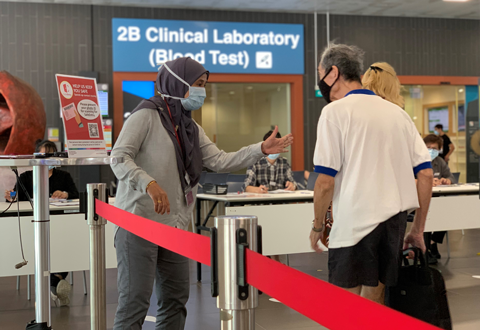
“Probably the most exciting thing to happen at triage was that we had a pregnant patient who suddenly experienced contractions at the counter while filling her declaration form!” shared Jimmy Sum, Senior Manager, Operations (Support Services) who oversees triage operations.
Jaw-dropper tales aside, the triage team has braved ups and downs since its inception almost seven months ago. Just last month, on Monday, 13 July, the triage team found themselves on high alert. The reason? The outpatient clinics had announced the week before that they would start welcoming their regular volume of patients back to NHCS – news that came almost three months after the circuit breaker period which saw a reduction in workload across the patient care areas.
Stepping up: The early days (click here to read how NHCS swiftly responded to DORSCON Orange)
Moving into circuit breaker mode
When the nation announced the roll-out of circuit breaker measures in early April, the triage team at NHCS correspondingly stepped up various measures such as SafeEntry check-in and out, travel and health declaration, stringent visiting policy with restricted number of accompanying persons for each patient, and safe distancing measures.
“The triage team will alert us when there are patients or visitors with travel history, flu-like symptoms or close contact with Covid-19. These patients have to undergo another screening before they are allowed into the premises,” said Assistant Director of Nursing (ADN), Chong Thye who oversees the secondary screening function, an added precautionary step to safeguard everyone’s health and safety.

The newly opened 2C Cardiac Clinic takes care of secondary screening procedures.
A makeshift clinic, 2C Cardiac Clinic was also set up at level two of NHCS to perform consultations, isolation and swab tests.
During this period of heightened vigilance, the triage which is manned by mainly a group of temporary staff and staff volunteers, constantly faces issues of enforcing the visiting policy. “While some patients did not know that only one accompanying person is allowed for a patient visit, there were some who refused to comply,” said Jimmy.

Triage leaders handle a myriad of situations from difficult patients, to manpower and logistic issues so that the screening work can continue to function safely and smoothly.
A new role – triage leader was created in March to help manage situations on the ground. Now, there are 10 triage leaders comprising staff volunteers from various departments, “We are glad to have these managers from various departments to help ensure smooth operations of the triage on a rotation basis. They would have to deal with and resolve every situation faced by the team.”
Suryanti Binte Tohid, Executive from Support Services who helps with the triage resource roster, shared that when the triage first started, its manpower resource was dependent solely on NHCS staff, “Before the setup of the triage at the early stages of Covid-19, the screening process was decentralised and done by individual departments. Then, when we had the triage at level two, we relied mainly on staff volunteers to man the two entry points,” she shared.
Realising that it might not be sustainable to have staff volunteers to man the triage, Support Services turned to the option of hiring temporary staff to augment the team.

About 13 temporary staff augment the manpower needs of triage (pictured are 10 temporary staff together with triage team members).
For the long haul: Teamwork triumphs
“As part of the pandemic protocol requirement, level two of the designated triage floor was converted to a transit floor. The lifts at level two, Lift Lobby C, were configured to segregate the movements to upper floors and lower floors to prevent cross-over of people. Two lifts were programmed to serve level one where the shuttle bus/drop off point are located, and to carparks and underpass to SGH campus at the basement levels, while the other two lifts serve the patient care service areas at the upper floors,” shared Victor Ang, Assistant Director, Operations (Support Services).

The configuration of lift lobby C smoothens traffic flow to triage as well as the distinct areas it serves.
With the closure of several public carparks within SGH campus, there has been an increase in the usage of NHCS carpark and in the movements of people, and hence, has also resulted longer waiting time for lifts at lobby C. Besides ensuring safe distancing, NHC’S very own Safe Distancing Ambassadors (SDAs) have also been deployed to manage the queue at lobby C during peak periods, and help communicate to patients and visitors on the wait. “Our SDAs have brought some respite to the team and is a great example of NHCS teamwork,” said Jimmy.
As triage operations sail into the last quarter of the year and possibly is the new normal now, Lim Chee Pheng, Director of Operations (Support Services) is confident that the triage team will continue to deliver an excellent job in keeping everyone safe, “The leaders and staff have done a splendid job to ensure that everyone visiting NHCS complies with the temperature scan, health declaration and SafeEntry requirements, and not forgetting their decisiveness and vigilance in dealing with challenging situations on a day-to-day basis.”
Three cheers to the hardworking triage team who keeps triage running like a well-oiled machine, and for keeping all of us safe!
--------------------------------------------------------------------------------
The Operations (Support Services) would like to extend their gratitude to all departments who have helped the triage team in one way or another, especially Cardiac Laboratory, Clinical Trials and Research Office, Corporate Development, Human Resource, National Heart Research Institute Singapore, Nursing Development Unit, Patient Liaison Services, Programme Development, Research and Administrative Development Office and Singapore Cardiac Data Bank and many more!
In addition, the team is thankful to have received kind sponsorships of drinks, fruits and bentos from many generous staff. Special thanks goes to Programme Development, Human Resources and Corporate Development!
*Disclaimer: Some photos were taken before the implementation of circuit breaker measures.













 Get it on Google Play
Get it on Google Play